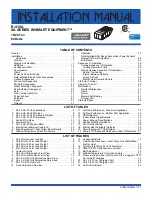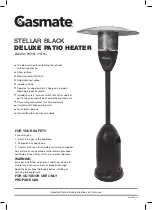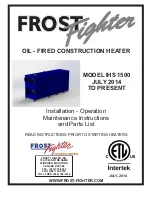
WHL-053 Rev. 00 Rel. 003 Date 7.21.17
40
Part 8 - Start-Up Preparation
A. Check / Control Water Chemistry
B. Check for Gas Leaks
Before starting the boiler, and during initial operation, smell near
the floor and around the boiler for gas odorant or any unusual odor.
Remove boiler front door and smell interior of boiler enclosure.
Do not proceed with startup if there is any indication of a gas leak.
Repair any leaks at once.
PROPANE BOILERS ONLY – The propane supplier mixes an odorant
with the propane to make its presence detectable. In some instances
the odorant can fade, and the gas may no longer have an odor.
Before startup (and periodically thereafter), have the propane
supplier verify the correct odorant level in the gas.
C. Condensate Removal
1. The boiler is a high efficiency condensing boiler. Therefore, the
unit has a condensate drain. Condensate fluid is nothing more than
water vapor, derived from combustion products, similar to that
produced by an automobile when it is initially started.
Condensation is slightly acidic (typically with a pH of 3 to 5) and
must be piped with the correct materials. Never pipe the condensate
using steel, copper, brass or other materials that will be subject to
corrosion. Plastic PVC or CPVC pipe are the only approved materials.
A condensate neutralizer, if required by local authorities, can be
made up of lime crystals, marble or phosphate chips that will
neutralize the condensate. This may be done by the installer or you
may purchase a condensate neutralizer from Westinghouse (7450P-
212).
2. The boiler is equipped with a ¾ female socket weld fitting
connection that must be piped to a local drain. It is very important
that the condensate line is sloped downward away from the boiler
to a suitable inside drain. If the condensate outlet on the appliance
is lower than the drain, you must use a condensate removal pump,
available from Westinghouse (554200). This pump is equipped with
two leads that can be connected to an alarm or another type of
warning device to alert the user of a condensate overflow, which, if
not corrected, could cause property damage.
3. If a long horizontal run is used, it may be necessary to create a vent
in the horizontal run to prevent a vacuum lock in the condensate
line.
4. Do not expose the condensate to freezing temperatures.
5. It is very important you support the condensation line to assure
proper drainage.
D. Final Checks Before Starting Boiler
1. Read Startup Procedures within this manual for proper steps to
start boiler. (See Startup Report to record steps for future reference.)
2. Verify the boiler and system are full of water and all system
components are correctly set for operation.
Ensure the boiler is full of water before firing the burner. Failure
to do so will damage the boiler. Such damage IS NOT covered by
warranty, and could result in property damage, severe personal
injury, or death.
3. Fill condensate trap with water.
4. Verify electrical connections are correct and securely attached.
5. Inspect exhaust vent and intake piping for signs of deterioration
from corrosion, physical damage or sagging. Verify exhaust vent and
intake piping are intact and correctly installed per Venting Section
and local codes.
Do not use petroleum-based cleaning or sealing compounds in the
appliance system. Damage to elastomer seals and gaskets in the
system could occur, resulting in substantial property damage.
Chemical imbalance of the water supply may affect efficiency and
cause severe damage to the appliance and associated equipment.
Water quality must be professionally analyzed to determine whether
it is necessary to treat the water. Various solutions are available to
adjust water quality. Adverse water quality will affect the reliability
of the system. In addition, operating temperatures above 135
o
F will
accelerate the build-up of lime scale and possibly shorten appliance
service life. Failure of an appliance due to lime scale build-up, low
pH, or other chemical imbalance IS NOT covered by the warranty.
The water must be potable, free of corrosive chemicals, sand, dirt, and
other contaminates. It is up to the installer to ensure the water does
not contain corrosive chemicals or elements that can damage the
heat exchanger. Potable water is defined as drinkable water supplied
from utility or well water in compliance with EPA secondary maximum
contaminant levels (40 CFR Part 143.3) as shown in the table below.
If the water contains contaminants higher than outlined by the EPA,
water treatment is recommended and additional, more frequent
maintenance may be required.
If you suspect that your water is contaminated in any way, discontinue
use of the appliance and contact an authorized technician or licensed
professional.
Contaminant
Maximum
Allowable
Level
Contaminant
Maximum
Allowable
Level
Total Hardness
(Commercial
Use - 140
o
F and
above water
temperature)
120 mg/l
(7 grains/gallon)
pH
6.5-8.5
Sulfate
205 mg/l
Total Dissolved
Solids (TDS)
500 mg/l
Aluminum
0.05 to 0.2 mg/l
Zinc
5 mg/l
Chloride
100 mg/l
Copper
1 mg/l
Dissolved
Carbon
Dioxide (CO2)
15 mg/l or
PPM
Iron
0.3 mg/l
Manganese
0.05 mg/l
E. Setting Up a Single Boiler
When power is applied to the boiler, the control first completes a
power-up systems check. During this time the combustion fan
may run. The display will initially show the current boiler outlet
temperature. If a fault is detected during the power-up test, the
control will display the appropriate fault code. Otherwise, the display
will continue to show the boiler outlet temperature and stand-by,
waiting for a demand for hot water. If the temperature of the tank
sensor falls below the tank set point minus the tank differential
temperature, a demand for hot water is generated by the control.
When a demand for hot water is received, the control begins the
following demand sequence. The boiler first turns on the pump (if
it is not wired to run continuously). Once the pump is running, the
control will display LOW WATER FLOW and wait for the water flow
in the system to increase to an acceptable level determined by
the flow switch on the outside of the boiler. (NOTE: This step may
happen very rapidly. If flow is adequate, LOW WATER FLOW may
never display.)
Summary of Contents for 220VWH
Page 36: ...WHL 053 Rev 00 Rel 003 Date 7 21 17 36 Figure 25 Internal Connection Diagram...
Page 57: ...WHL 053 Rev 00 Rel 003 Date 7 21 17 57 Figure 29 Condensate Detail...
Page 60: ...WHL 053 Rev 00 Rel 003 Date 7 21 17 60 Figure 32 Replacement Parts All Models...
Page 66: ...WHL 053 Rev 00 Rel 003 Date 7 21 17 66 Maintenance Notes...
















































